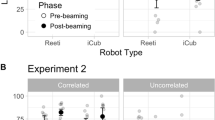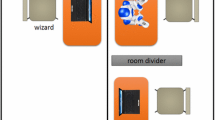Abstract
To let humanoid robots behave socially adequate in a future society, we started to explore laughter as an important para-verbal signal known to influence relationships among humans rather easily. We investigated how the naturalness of various types of laughter in combination with different humanoid robots was judged, first, within a situational context that is suitable for laughter and, second, without describing the situational context. Given the variety of human laughter, do people prefer a certain style for a robot’s laughter? And if yes, how does a robot’s outer appearance affect this preference, if at all? Is this preference independent of the observer’s cultural background? Those participants, who took part in two separate online surveys and were told that the robots would laugh in response to a joke, preferred one type of laughter regardless of the robot type. This result is contrasted by a detailed analysis of two more surveys, which took place during presentations at a Japanese and a German high school, respectively. From the results of these two surveys, interesting intercultural differences in the perceived naturalness of our laughing humanoids can be derived and challenging questions arise that are to be addressed in future research.











Similar content being viewed by others
Explore related subjects
Discover the latest articles, news and stories from top researchers in related subjects.Notes
Videos of the laughing robots can be found at http://www.becker-asano.de.
References
Bachorowski JA, Owren MJ (2001) Not all laughs are alike: voiced but not unvoiced laughter readily elicits positive affect. Psychol Sci 12(3):252–257
Bartneck C (2002) eMuu-an embodied emotional character for the ambient intelligent home. Ph.D. thesis, Universiteit Eindhoven
Bechara A, Damasio H, Damasio AR (2000) Emotion, decision making and the orbitofrontal cortex. Cerebral Cortex 10(3):295–307
Becker-Asano C, Ishiguro H (2009) Laughter in social robotics—no laughing matter. In: 8th International workshop on social intelligence design (SID2009), pp 287–300
Becker-Asano C, Nishio S, Ogawa K, Ishiguro H (2010) Investigating emotional effects of an android’s laughter. IEEE Trans Affect Comput (submitted)
Becker-Asano C, Wachsmuth I (2010) Affective computing with primary and secondary emotions in a virtual human. Auton Agents Multi Agent Syst 20(1):32–49. doi:10.1007/s10458-009-9094-9
Breazeal C (2003) Emotion and sociable humanoid robots. Int J Hum Comput Stud 59:119–155
Breazeal C (2004) Function meets style: insights from emotion theory applied to HRI. IEEE SMC Trans C 32:187–194
Campbell N (2007) Whom we laugh with affects how we laugh. In: Proceedings of interdisciplinary workshop on the phonetics of laughter
Dautenhahn K (2007) Socially intelligent robots: dimensions of human–robot interaction. Philos Trans R Soc 362:679–704
Gervais M, Wilson DS (2005) The evolution and functions of laughter and humor: a synthetic approach. Q Rev Biol 80:395–430
Glenn P (2003) Laughter in interaction. Cambride University Press, Cambride
GoldWave Incorporated (2009) GoldWave Audio Editor. http://www.goldwave.com
Grammer K (1990) Strangers meet: laughter and nonverbal signs of interest in opposite-sex encounters. J Nonverb Behav 14(4):209–236
Grammer K, Eibl-Eibesfeldt I (1990) The ritualisation of laughter. In: Natürlichkeit der Sprache und der Kultur, chap. 10. Brockmeyer, pp 192–214
Hayashi K, Kanda T, Miyashita T, Ishiguro H, Hagita N (2008) Robot manzai: robot conversation as a passive-social medium. Int J Human Robot 5:67–86
Ishi C, Ishiguro H, Hagita N (2008) Analysis of inter- and intra-speaker variability of head motions during spoken dialogue. In: Proceedings of the international conference on auditory-visual speech processing, pp 37–42
Kanda T, Ishiguro H, Ono T, Imai M, Mase K (2002) Multi-robot cooperation for human-robot communication. In: International workshop on robot and human interactive communication, pp 271–276. doi:10.1109/ROMAN.2002.1045634
Kipper S, Todt D (2001) Variation of sound parameters affects the evaluation of human laughter. Behavior 138:1161–1178
Laskowski K, Burger S (2007) On the correlation between perceptual and contextual aspects of laughter in meetings. In: Proceedings of the interdisciplinary workshop on the phonetics of laughter, pp 55–60
LeDoux JE (2000) Emotion circuits in the brain. Annu Rev Neurosci 23:155–184
Murphy ST, Zajonc R (1993) Affect, cognition, and awareness: affective priming with optimal and suboptimal stimulus exposures. J Personal Soc Psychol 64:723–739
Panksepp J (2000) The riddle of laughter: neural and psychoevelutionary underpinnings of joy. Am Psychol Soc 9(6):183–186
Picard R (2003) Affective computing: challenges. Int J Hum Comput Stud 59:55–64
Prendinger H, Becker C, Ishizuka M (2006) A study in users’ physiological response to an empathic interface agent. Int J Human Robot 3(3):371–391
Provine RR (2005) Laughing, tickling, and the evolution of speech and self. Curr Direct Psychol Sci 13:215–218
Scherer K (1994) Affect bursts. In: Emotions: essays on emotion theory, pp 161–196. Erlbaum. http://www.affective-sciences.org/node/509
Scherer KR (2005) What are emotions? And how can they be measured. Soc Sci Inf 44:695–792
Shiwa T, Kanda T, Imai M, Ishiguro H, Hagita N (2008) How quickly should communication robots respond? In: Proceedings of international conference on human robot interaction, pp 153–160
Vinayagamoorthy V, Gillies M, Steed A, Tanguy E, Pan X, Loscos C, Slater M (2006) Building expression into virtual characters: state of the art report. Technical report, EUROGRAPHICS 2006
Yoshikawa Y, Shinozawa K, Ishiguro H, Hagita N, Miyamoto T (2006) Responsive robot gaze to interaction partner. In: Proceedings of robotics: science and systems II
Zecca M, Roccella S, Carrozza M, Miwa H, Itoh K, Cappiello G, Cabibihan JJ, Matsumoto M, Takanobu H, Dario P, Takanishi A (2004) On the development of the emotion expression humanoid robot WE-4RII with RCH-1. In: 4th IEEE/RAS international conference on humanoid robots, pp 235–252
Acknowledgments
The first author is supported by a post-doctoral fellowship of the Japan Society for the Promotion of Science.
Author information
Authors and Affiliations
Corresponding author
Additional information
This article is an extended version of Becker-Asano and Ishiguro (2009).
Rights and permissions
About this article
Cite this article
Becker-Asano, C., Kanda, T., Ishi, C. et al. Studying laughter in combination with two humanoid robots. AI & Soc 26, 291–300 (2011). https://doi.org/10.1007/s00146-010-0306-2
Received:
Accepted:
Published:
Issue Date:
DOI: https://doi.org/10.1007/s00146-010-0306-2




